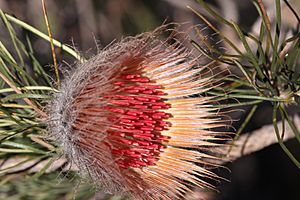Shaggy dryandra facts for kids
Quick facts for kids Shaggy dryandra |
|
|---|---|
 |
|
| Banksia splendida at Tathra National Park, Western Australia | |
| Scientific classification | |
| Genus: |
Banksia
|
| Species: |
splendida
|
| Synonyms | |
|
|
The Banksia splendida, also known as the shaggy dryandra, is a special type of shrub. It grows only in the southwest part of Western Australia. This plant has long, pointy leaves that feel woolly underneath. Its flowers are cream-coloured and maroon or yellow. They grow in groups of 65 to 115 flowers. After flowering, it produces up to eight egg-shaped seed pods.
Contents
What the Shaggy Dryandra Looks Like
The shaggy dryandra is a bushy plant with many branches. It usually grows up to 2 meters (about 6.5 feet) tall. It doesn't have a special woody base that helps it regrow after fire.
Its leaves are long and thin, like needles, and have sharp points. They are usually 50 to 100 millimeters (about 2 to 4 inches) long and 1 to 1.5 millimeters wide. The edges of the leaves curl under, and the bottom side is covered in soft, woolly hairs.
The flowers grow in a round cluster. Each cluster has between 65 and 115 flowers. At the base of the flower cluster are long, thin leaf-like parts called bracts, which are about 40 to 50 millimeters long. The flowers themselves are cream-coloured at the bottom and maroon or yellow at the top. They are about 24 to 30 millimeters long. The part of the flower that holds the pollen is cream-coloured and has a pale red tip.
This plant usually flowers from July to September. After the flowers, it forms egg-shaped seed pods. These pods are about 18 to 25 millimeters (about 0.7 to 1 inch) long.
How the Shaggy Dryandra Got Its Name
This plant was first found by a botanist named James Drummond in the late 1840s. It was first mentioned in a science paper in 1852. Back then, it was called Dryandra speciosa. The word speciosa comes from a Latin word meaning "showy."
Over time, scientists studied plants more closely, especially using DNA information. In 2007, two scientists, Austin Mast and Kevin Thiele, decided that the Dryandra group of plants should actually be part of the Banksia group.
Because there was already a plant called Banksia speciosa, they had to give the shaggy dryandra a new name. They chose splendida, which is Latin for "brilliant." So, its full scientific name became Banksia splendida.
There are also two slightly different types, or subspecies, of shaggy dryandra:
- Banksia splendida subsp. splendida: This type has more flowers in each cluster (85 to 115) and slightly shorter seed pods (18 to 21 millimeters).
- Banksia splendida subsp. macrocarpa: This type has fewer flowers (65 to 75) and longer seed pods (24 to 25 millimeters).
Where the Shaggy Dryandra Lives
The two types of shaggy dryandra grow in special areas called kwongan. These are areas of sandy soil with many shrubs. They grow in two separate places in Western Australia.
The splendida subspecies is found near a town called Tammin. The macrocarpa subspecies grows between the Tathra National Park and Badgingarra.
Protecting the Shaggy Dryandra
The government of Western Australia keeps track of plants that might be in danger.
- Banksia splendida subsp. splendida is listed as "Priority Two." This means it's not very well known and is found in only a few places.
- Banksia splendida subsp. macrocarpa is listed as "Priority Three." This means it's also not very well known and found in only a few places, but it's not in immediate danger right now.

